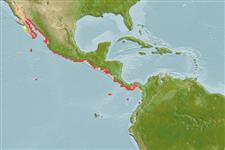>
Blenniiformes (Blennies) >
Blenniidae (Combtooth blennies) > Salariinae
Etymology: Entomacrodus: Greek, ento = inside + Greek, makros = big + Greek, odous = teeth (Ref. 45335).
More on authors: Jordan & Gilbert.
Environment: milieu / climate zone / depth range / distribution range
Écologie
marin récifal. Tropical
Eastern Central Pacific: Gulf of California to Panama, including offshore islands such as Tres Marias, Revillagigedo, Clipperton, and Cocos.
Taille / Poids / Âge
Maturity: Lm ? range ? - ? cm
Max length : 7.5 cm TL mâle / non sexé; (Ref. 11482)
Facultative air-breathing (Ref. 126274); Adults inhabit shallow, weed-covered rocky reefs, including tide pools (Ref. 11482). Oviparous. Eggs are demersal and adhesive (Ref. 205), and are attached to the substrate via a filamentous, adhesive pad or pedestal (Ref. 94114). Larvae are planktonic, often found in shallow, coastal waters (Ref. 94114).
Life cycle and mating behavior
Maturities | Reproduction | Spawnings | Egg(s) | Fecundities | Larves
Oviparous, distinct pairing (Ref. 205).
Allen, G.R. and D.R. Robertson, 1994. Fishes of the tropical eastern Pacific. University of Hawaii Press, Honolulu. 332 p. (Ref. 11482)
Statut dans la liste rouge de l'IUCN (Ref. 130435)
Menace pour l'homme
Harmless
Utilisations par l'homme
Outils
Articles particuliers
Télécharger en XML
Sources Internet
Estimates based on models
Preferred temperature (Ref.
123201): 22.4 - 29.1, mean 27.9 °C (based on 154 cells).
Phylogenetic diversity index (Ref.
82804): PD
50 = 0.5000 [Uniqueness, from 0.5 = low to 2.0 = high].
Bayesian length-weight: a=0.00741 (0.00335 - 0.01640), b=3.02 (2.83 - 3.21), in cm total length, based on LWR estimates for this (Sub)family-body shape (Ref.
93245).
Niveau trophique (Ref.
69278): 2.0 ±0.00 se; based on food items.
Résilience (Ref.
120179): Haut, temps minimum de doublement de population inférieur à 15 mois (Preliminary K or Fecundity.).
Fishing Vulnerability (Ref.
59153): Low vulnerability (10 of 100).
Nutrients (Ref.
124155): Calcium = 214 [101, 396] mg/100g; Iron = 0.991 [0.533, 1.808] mg/100g; Protein = 17.9 [16.6, 19.1] %; Omega3 = 0.075 [0.036, 0.148] g/100g; Selenium = 18.1 [8.1, 43.7] μg/100g; VitaminA = 119 [28, 493] μg/100g; Zinc = 3.05 [1.93, 4.61] mg/100g (wet weight);
